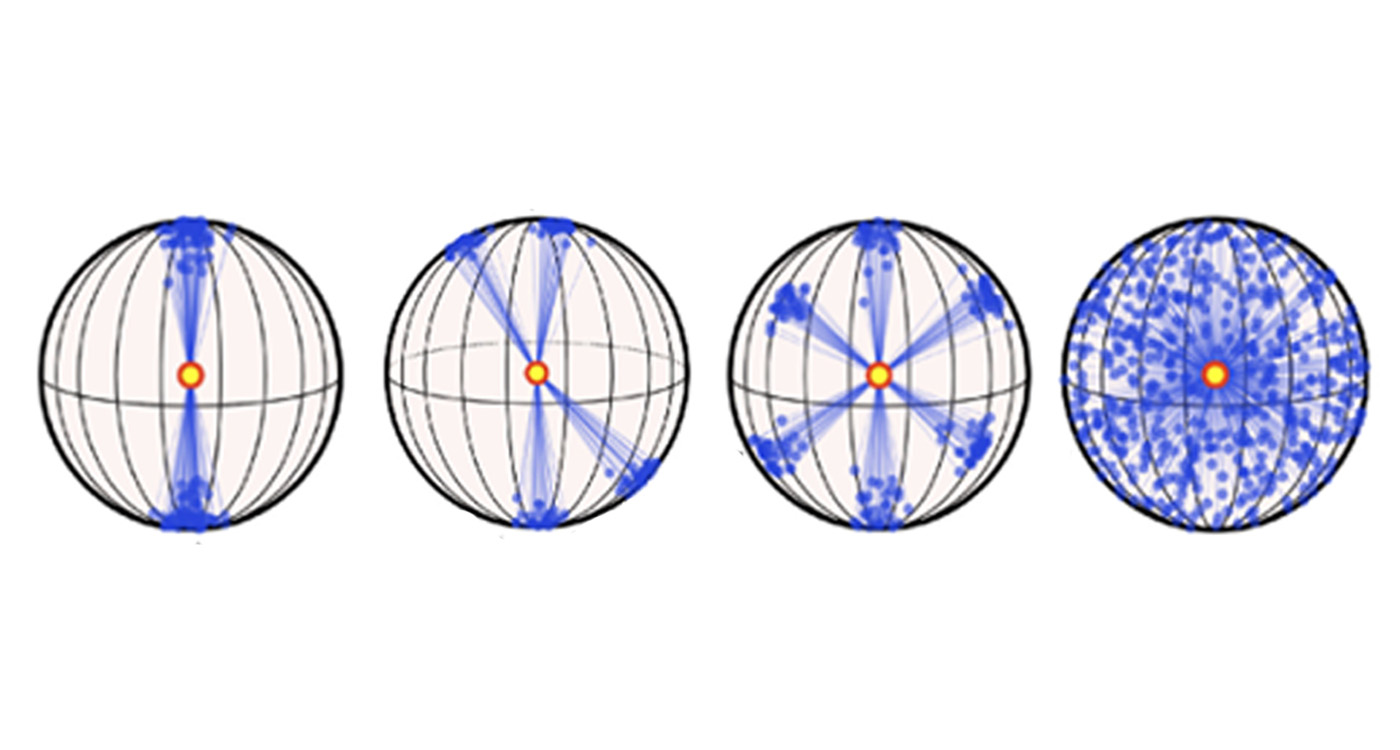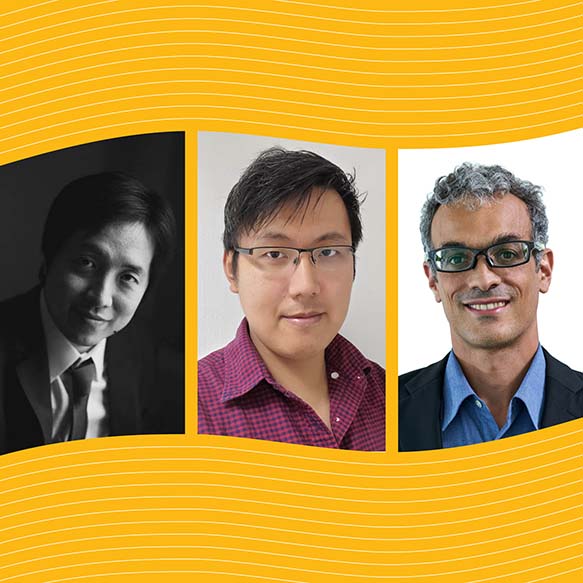Highlights
Randomness from the deep
 Each of these sets of qubits states (blue) has the same average (yellow), but some are more randomly distributed than others. Such state distributions may emerge as a quantum system thermalises. Deep thermalisation (right) makes the most random states of all. Image credit: adapted from PRX Quantum 4 030322, (2023).
Each of these sets of qubits states (blue) has the same average (yellow), but some are more randomly distributed than others. Such state distributions may emerge as a quantum system thermalises. Deep thermalisation (right) makes the most random states of all. Image credit: adapted from PRX Quantum 4 030322, (2023).
A set of random quantum states is a surprisingly useful starting point in applications ranging from cryptography to the benchmarking of quantum devices – but challenging to make. CQT Fellow Ho Wen Wei and collaborator Matteo Ippoliti have studied a novel phenomenon known as ‘deep thermalisation’ that could produce such random states naturally from time-evolution.
Deep thermalisation appears in the dynamics of large quantum systems. After it was first reported in January 2023, Wen Wei contributed to developing a rigorous theory of how it arises. In this new work with Matteo, published 16 August in PRX Quantum, he investigates its timescales.
Deep thermalisation
Thermalisation is a familiar process in everyday life – think of a hot cup of coffee gradually cooling to room temperature when left by itself. Quantum thermalisation is also ubiquitous. Any local imbalance of energy, or more generally, quantum information, tends to spread out over the entire quantum system over time.
“Conceptually, this is interesting as it furnishes an ‘organising principle’ to predict the long-time fate of any system using only coarse-grained, macroscopic information, without having to solve any specific system’s full microscopic dynamics,” says Wen Wei.
In regular thermalisation, researchers are concerned only with the state of the system in question, ignoring the state of the environment. The system relaxes into a maximally entropic mixed state. Contrastingly, in deep thermalisation, researchers consider the scenario where the state of the environment is not ignored, but instead measured, allowing one to correlate a quantum state of the system with a particular measurement outcome of the environment.
Together, this collection of pure quantum states, conditioned upon knowledge of the environment, constitute a novel theoretical object called the ‘projected ensemble’. What researchers found in earlier papers on deep thermalisation is that such ensembles, for a large class of quantum dynamics, become as random as possible over time. That is, the pure quantum states eventually become uniformly distributed in Hilbert space, the space used to describe quantum states. The picture above visualises qubit states in their 2-dimensional Hilbert space.
Timescales of randomness
How quickly does thermalisation happen? Researchers know that regular thermalisation is governed by the ‘entanglement velocity’, which describes the rate of quantum information spreading in space. Wen Wei and Matteo define a ‘purification velocity’ that plays an analogous role in deep thermalisation. This velocity describes the rate at which mixed quantum states are transformed to pure quantum states through the act of measurements. In the context of deep thermalisation, this sets a bound on how many distinct states can appear in the projected ensemble, limiting its randomness at any given time. Over time, this limitation is alleviated.
The researchers find there is an interplay of purification velocity and entanglement velocity in deep thermalisation. The deep thermalisation time to regular thermalisation time is bounded from below by a ratio of the entanglement to purification velocity. These ratios can be tuned arbitrarily large in different physical models, resulting in a stronger separation of timescales, indicating distinct physical processes underlying regular and deep thermalisation. Further, the authors find that deep thermalisation rates serve as a proxy for the degree of quantum information scrambling, an important topic in the field of quantum dynamics. The researchers support their predictions by running numerical simulations on a toy model of one-dimensional quantum circuits.
“Our results give a better understanding of fundamental features of quantum dynamics,” says Wen Wei. In the topic of deep thermalisation, many open questions remain. He says, “For example, it would be interesting to understand how the phenomenon gets modified if we impose constraints on the system. Fundamentally, it is also an intriguing question to ask if the appearance of deep thermalisation represents a new perspective on the old and venerable field of quantum chaos.”
Learn more
Related Stories
New blueprint to realise novel quantum phase transition November 09 2023 | |
 | Welcome to three CQT Fellows June 27 2023 |






